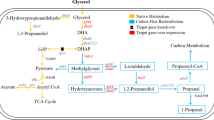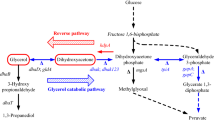Abstract
The microbial production of 1,3-propanediol (1,3-PD) by Klebsiella pneumoniae involves the formation of various by-products, which are synthesized through the oxidative pathway. To eliminate the by-products synthesis, the oxidative branch of glycerol metabolism was inactivated by constructing two mutant strains. In one of the mutant strains, the structural genes encoding glycerol dehydrogenase and dihydroxyacetone kinase were deleted from the chromosomal DNA, whereas in the second mutant strain dhaR, which is a putative transcription factor that activates, gene expression was deleted from the chromosomal DNA. In the resultant mutant strains lacking the dhaT gene encoding 1,3-PD oxidoreductase, which was simultaneously deleted while replacing the native promoter with the lacZ promoter, the by-product formation except for acetate was eliminated, but it still produced 1,3-PD at a lower level, which might be due to a putative oxidoreductase that catalyzes the production of 1,3-PD. The recombinant strains in which the reductive pathway was recovered produced slightly lower amount of 1,3-PD as compared to the parent strain, which might be due to the reduced activity of DhaB caused by the substitution of the promoter. However, the production yield was higher in the recombinant strain (0.57 mol mol−1) than the wild type Cu strain (0.47 mol mol−1).






Similar content being viewed by others
References
Bächler C, Schneider P, Bächler P, Lustig A, Erni B (2005) Escherichia coli dihydroxyacetone kinase controls gene expression by binding to transcription factor DhaR. EMBO J 24:283–293
Bhatia SK, Kurian JV (2008) Biological characterization of Sorona polymer from corn-derived 1, 3-propanediol. Biotechnol Lett 30:619–623
da Silva GP, Mack M, Contiero J (2009) Glycerol: a promising and abundant carbon source for industrial microbiology. Biotechnol Adv 27:30–39
Fournet-Fayard S, Joly B, Forestier C (1995) Transformation of wild type Klebsiella pneumoniae with plasmid DNA by electroporation. J Microbiol Methods 24:49–54
Gust B, Kieser T, Chater KF (2002) REDIRECT technology: PCR-targeting system in Streptomyces coelicolor. John Innes Centre, UK
Haas T, Wiegand N, Arntz D (1994) Process for the production of 1,3-propanediol. US patent NO. 5334778
Hao J, Wang W, Tian J, Li J, Liu D (2008) Decrease of 3-hydroxypropionaldehyde accumulation in 1, 3-propanediol production by over-expressing dhaT gene in Klebsiella pneumoniae TUAC01. J Ind Microbiol Biotechnol 35:735–741
Johnson EA, Lin ECC (1987) Klebsiella pneumoniae 1, 3-propanediol: NAD + oxidoreductase. J Bacteriol 169:2050–2054
Johnson DT, Taconi KA (2007) The glycerin glut: options for the value-added conversion of crude glycerol resulting from biodiesel production. Environ Prog 26:338–348
Marçal D, Rêgo AT, Carrondo MA, Enguita FJ (2009) 1, 3-propanediol-dehydrogenase from Klebsiella pneumoniae : decameric quaternary structure and possible subunit cooperativity. J Bacteriol 191:1143–1151
Nakamura CE, Whited GM (2003) Metabolic engineering for the microbial production of 1, 3-propanediol. Curr Opin Biotechnol 14:454–459
Nath N, Deb JK (1997) Curing of plasmids of Corynebacterium renale: lactose metabolism and cephaloridine resistance are not plasmid encoded. Biotechnol Lett 19:163–166
Oh BR, Seo JW, Choi MH, Kim CH (2008) Optimization of culture conditions for 1, 3-propanediol production from crude glycerol by Klebsiella pneumoniae using response surface methodology. Biotechnol Bioprocess Eng 13:524–532
Pagliaro M, Ciriminna R, Kimura H, Rossi M, Pina CD (2007) From glycerol to value-added products. Angew Chem Int Ed 46:4434–4440
Raynaud C, Sarçabal P, Meynial-Salles I, Croux C, Soucaille P (2003) Molecular characterization of the 1, 3-propaneidol (1, 3-PD) operon of Clostridium butyricum. Proc Natl Acad Sci U S A 100:5010–5015
Skraly FA, Lytle BL, Cameron DC (1998) Construction and characterization of a 1, 3-propanediol operon. Appl Environ Microbiol 64:98–105
Slaugh LH, Powell JB, Forschner TC, Semple TC, Weinder PR (1995) Process for preparing 1,3-propandediol. US patent No 5463146
Sun J, van den Heuvel J, Soucaille P, Qu Y, Zeng AP (2003) Comparative genomic analysis of dha regulon and related genes for anaerobic glycerol metabolism in bacteria. Biotechnol Prog 19:263–272
Tobimatsu T, Kajiura H, Toraya T (2000) Specificities of reactivating factors for adenosylcobalamin-dependent diol dehydratase and glycerol dehydratase. Arch Microbiol 174:81–88
Tong IT, Liao HH, Cameron DC (1991) 1, 3-propanediol production by Escherichia coli expressing genes from the Klebsiella pneumoniae dha regulon. Appl Environ Microbiol 57:3541–3546
Toraya T, Krodel E, Mildvan AS, Abeles RH (1979) Role of peripheral side chains of vitamin B12 coenzymes in the reaction catalyzed by dioldehydrase. Biochemistry 18:417–426
Xiu ZL, Zeng AP (2008) Present state and perspective of downstream processing of biologically produced 1, 3-propanediol and 2, 3-butanediol. Appl Microbiol Biotechnol 78:917–926
Yang G, Tian J, Li J (2007) Fermentation of 1, 3-propanediol by a lactate deficient mutant of Klebsiella oxytoca under microaerobic conditions. Appl Microbiol Biotechnol 73:1017–1024
Zhang Y, Li Y, Du C, Liu M, Cao Z (2006) Inactivation of aldehyde dehydrogenase: a key factor for engineering 1, 3-propanediol production by Klebsiella pneumoniae. Metab Eng 8:578–586
Zhang Y, Huang Z, Du C, Li Y, Cao Z (2009) Introduction of an NADH regeneration system into Klebsiella oxytoca leads to an enhanced oxidative and reductive metabolism of glycerol. Metab Eng 11:101–106
Zhao L, Zheng Y, Ma X, Wei D (2009) Effects of over-expression of glycerol dehydrogenase and 1,3-propanediol oxidoreductase on bioconversion of glycerol into 1,3-propanediol by Klebsiella pneumoniae under micro-acrobic conditions. Bioprocess Biosyst Eng. doi:https://doi.org/10.1007/s00449-008-0250-4
Zheng P, Wereath K, Sun J, van den Heuvel J, Zeng AP (2006) Overexpression of genes of the dha regulon and its effects on cell growth, glycerol fermentation to 1, 3-propanediol and plasmid stability in Klebsiella pneumoniae. Process Biochem 41:2160–2169
Acknowledgment
This study was supported by the Ministry of Education, Science and Technology, Korea.
Author information
Authors and Affiliations
Corresponding author
Rights and permissions
About this article
Cite this article
Seo, MY., Seo, JW., Heo, SY. et al. Elimination of by-product formation during production of 1,3-propanediol in Klebsiella pneumoniae by inactivation of glycerol oxidative pathway. Appl Microbiol Biotechnol 84, 527–534 (2009). https://doi.org/10.1007/s00253-009-1980-1
Received:
Revised:
Accepted:
Published:
Issue Date:
DOI: https://doi.org/10.1007/s00253-009-1980-1




